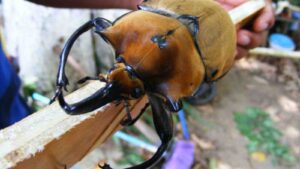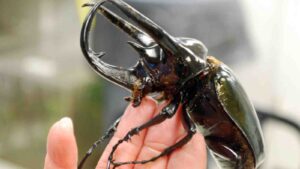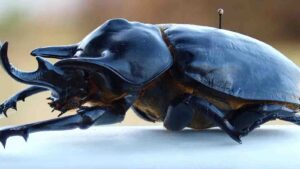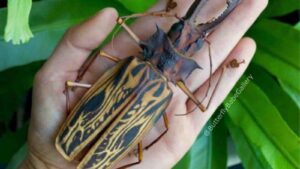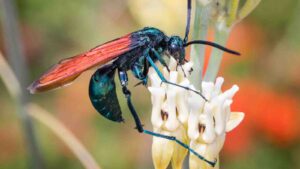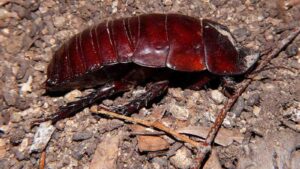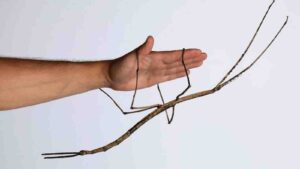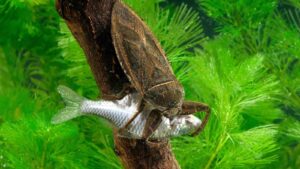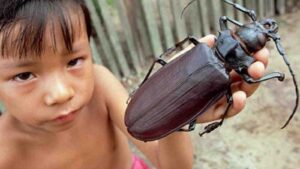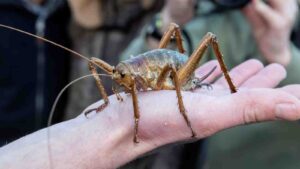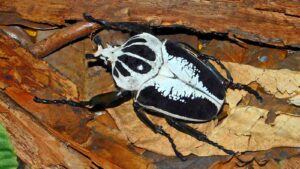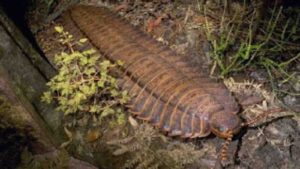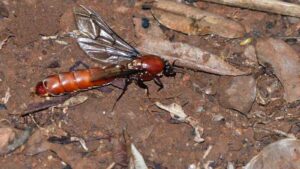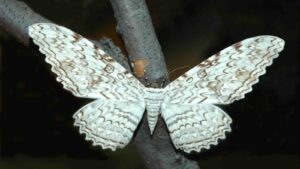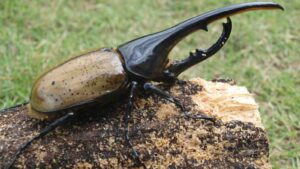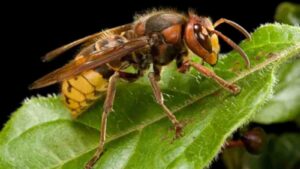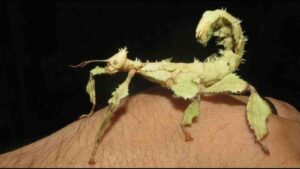Top 20 massive insects that are actually real
Summary
Top 20 massive insects that are actually real. We all love animals. However, when it comes to insects, we don’t show much interest. Because of their various shapes, colors, and scariest yet interesting size. You will be amazed to know […]

Top 20 massive insects that are actually real. We all love animals. However, when it comes to insects, we don’t show much interest. Because of their various shapes, colors, and scariest yet interesting size. You will be amazed to know about some of the largest insects’s existence in the world. Here are the top 20 massive insects that are actually real.
Video: Top 20 massive insects that are actually real
Elephant beetle
Elephant beetle: this giant insect is a rhinoceros beetle belonging to the Scarabaeidae family. The males can grow up to 13 cm, but females are 2-3 times smaller. They are actually black in color and covered with a coat of fine microscopic hairs. They are located in southern Mexico, Central America, and South American rainforests.
Atlas beetle
The Atlas beetle is a species of rhinoceros beetle. It is named after Atlas, a Titan condemned to hold up the sky for eternity in Greek mythology. The males are larger than the females, reaching a length of up to 13 centimeters. The larva of the Atlas beetle is known for its fierce behavior, including biting if touched. Unverified reports exist of larvae that live together fighting to the death if there’s not enough space or food. Atlas beetle lives in southern Asia, especially Indonesia.
Video: Top 20 massive insects that are actually real
Actaeon beetle
The Actaeon beetle is also a rhinoceros beetle belonging to the Scarabaeidae family. It is named after Actaeon, a famous Theban hero in Greek mythology. As mentioned above, with a large, bulky body, it is one of the largest of all beetles, measuring up to 7 centimeters across, with a body length of about 5–12 centimeters. The males can grow to be 13.5 cm long by 4 cm thick. This species can be found in South America, particularly in Bolivia, Brazil, Colombia, Ecuador, French Guiana, Guyana, Panama, Peru, Suriname, and Venezuela.
Macrodontia cervicornis
Macrodontia cervicornis is one of the largest insects, with known specimens exceeding 17 cm in length. Part of this length is due to the enormous mandibles, from which it derives both of the names in its binomen: macrodontia means “long tooth,” and cervicornis means “deer antler.” It is also known as the “Sabertooth Longhorn Beetle.” Most of this species’ life is spent in the larval stage, which can last up to 10 years, and the larvae of M. cervicornis are extremely large, reaching up to 21 cm in length.
Tarantula Hawk
These enormous wasps are so large and ferocious that they are capable of hunting and feeding on tarantulas. Their legs have hooks on the ends, which they use to latch onto their victims, and their stinger is rated as among the most painful in the world. Luckily, they are mostly docile unless harassed, but this is one mean bug you wouldn’t want to encounter!
Giant Burrowing Cockroach
Also called the rhinoceros cockroach, this insect is the heaviest cockroach in the world. Oddly enough, this is one roach you may want to keep around. Unlike other cockroaches, the rhinoceros cockroach doesn’t have wings, isn’t considered to be a pest, and plays an important role in its ecosystem by breaking down dead leaves. Some people have found that they make good pets. Found in Australia, these bugs can live for as long as 10 years and can grow to over 3 inches in length.
Queen Alexandra’s Birdwing
The largest butterfly in the world, Queen Alexandra’s birdwing lives up to its name with a wingspan of over 1 foot. Found only in remote regions of Papua New Guinea, the first specimen ever found was taken down using a shotgun. Though it was only discovered in the West in 1906, this gentle giant is already considered endangered, primarily because of encroaching development in its native habitats, mostly from palm oil plantations.
Praying Mantis
The world’s largest praying mantis was recorded at about 18 centimeters long in Southern China in 1929. According to Wikipedia, they can reach lengths of 20 cm. As an apex scary insect, the praying mantis feeds mainly on other insects. It is, however, documented that larger praying mantises are able to consume small reptiles and even small mammals or birds.
Phryganistria chinensis Zhao
Until 2016, the longest insect in the world was Phobaeticus chani, a stick insect with one specimen held in the Natural History Museum in London measuring 56.7 centimeters. Without legs fully extended, the body alone still measures an impressive 357 mm. But, in 2016, a new species of stick insect in southern China has been declared the world’s longest bug: Phryganistria chinensis Zhao, at 62.4 cm. It is named after Zhao Li of the Insect Museum of West China, who spent years searching for the massive insect described by locals.
Meganeuropsis permiana
This worst insect is an extinct genus of griffinfly, order Meganisoptera, known from the Early Permian of North America, and represents the biggest known insect of all time. The genus includes two described species: Meganeuropsis permiana was described in 1937 from Elmo, Kansas. It was one of the largest known insects that ever lived, with a reconstructed wing length of 330 millimeters, an estimated wingspan of up to 710 millimeters, and a body length from head to tail of almost 43 centimeters.
Read More: Weirdest things washed up on the beach
Giant water bug
These dangerous insects, also known as toe-biters and alligator ticks, can reach lengths rivaling some of the largest beetles in the world. Giant water bugs can grow as long as 4 inches. Known as voracious predators in the streams and ponds where they live, giant water bugs can deliver a painful bite with their giant pincers. When they grab their prey, they use their beaks to inject them with poisonous digestive juices, reports Scientific American. They wait a few minutes, then suck up the resulting liquid dinner.
Titan beetle
The titan beetle is widely rated as the scariest insect in the world. The largest reliable measured specimen was 16.7 cm in length. Several 18+ cm specimens are reputed. The titan beetle is comparable to such beetles as the Hercules beetle and the Macrodontia cervicornis. But the Hercules beetle males have an enormous horn on the pronotum or thorax, making up around half of its total length.
Giant Weta
On the heavy side of the insect world, we find the Giant Weta, which is only found in New Zealand. Thank goodness. Related to crickets, these most dangerous insects can be over 4 inches long, not including legs and antennae, and weigh over 2 and a half ounces, which is more than a sparrow. They’re so big that, unlike their cricket relatives, Giant Wetas are too heavy to jump around or fly. They’re not pretty. In fact, the name Weta comes from the Maori word “Weta punga,” which means “God of the Ugly Things.”
Goliathus regius
Over in Africa, they grow some big beetles. Take the Goliath Beetle, a dense 4 inches that can be 3 and a half ounces in its piggy larval stage. Not only are they big, but they’re also lazy. They like to wait until late in the day after the sun has had a chance to warm them up before they start moving around, kind of like a teenager. They can fly. Fortunately, they like to save this trick for escaping when they’re scared, not to pounce on innocent passersby. But that could change. Although they seem to be vegetarian in the wild, captive ones have shown a hankering for protein and will happily chow down on dog and cat food.
Arthropleura
Unless you’re one of those wacky bug lovers, you probably don’t want to meet any of the insects we’ve seen so far. But here’s one to wrap up our list that would test the nerve of even the most intrepid entomologist. Arthropleura can grow to around 8 feet in length and two or more feet wide, with dozens of sets of legs running down the entire length of its body like a centipede. It is easily the largest invertebrate species that ever existed. A creature like this can eat pretty much anything it wants, but thankfully Arthropleura chooses to dine exclusively on plants.
Dorylus helvolus
Red driver ants are big. The males are really big. But the queens. They’re scary big. Like, 2 inches big. And they have just the kind of attitude you want in a huge ant: really aggressive with a bite like hot, burning lava. You can find them in the lower parts of Africa, roaming around in nomadic colonies numbering in the thousands. They march around going wherever the food is, which can often be where people are. Compost piles are known to be a smorgasbord of treats for Red Driver Ant colonies, where they settle down to devour every scrap of edible goodness hidden within. They are rarely disturbed while they feast.
Thysania Agrippina
If you walked through a forest in South or Central America and passed by a tree where a White Witch Moth was sitting, even though its wingspan is 12 inches more, odds are you wouldn’t even notice it. Their coloration is so beautiful that you won’t believe they are real, but they are also perfectly adapted to blend in with their favorite trees. But tree bark isn’t the only thing this giant bug gets mistaken for; when flying, it’s so big that it often gets mistaken for other flying creatures, such as bats.
Dynastes hercules
These largest insects swagger around the jungles of South America, showing off the huge horn-like pincers on the foreheads of their impressive 7-inch-long bodies. At least the males do—the females don’t have this distinctive feature, although the girls’ bodies do grow a bit longer.
Proportionately speaking, they are the strongest creature on earth for their size, able to carry 850 times their own body weight.
Hornet
Like any other social wasp, they will defend their nest if the colony is disrupted. But in most cases, they will not do anything if people aren’t aggressive toward them. Giant hornets have longer stingers than a honeybee’s, and hornets do not break off their stingers when they sting. The one underlying factor that makes hornets so dangerous is their sting. Although the likelihood of getting stung by a hornet is very small, when they do decide to attack, it can be fatal. Hornets release more venom per sting than any other stinging insect.
Read More: 20 People With Real Super Powers You Won’t Believe Exist
Giant Prickly Stick
This species of stick insect looks more like a cactus than like a twig. Its body is bulky and covered in small spines. On its legs it has big lobes that are also spiked and look like leaves of a desert plant. These large insects are often light to mid-brown, but occasionally you can find green, beige, or dark brown varieties. There is also a rare “lichen” type color that can be found in some young Giant Prickly Stick Insect females. Their color depends on the conditions in which they are kept, but it is not entirely sure which conditions you need to provide to induce your stick insects to change color.
Which insect terrifies you? Do you know any other insect like this? Let us know in the comment section.
